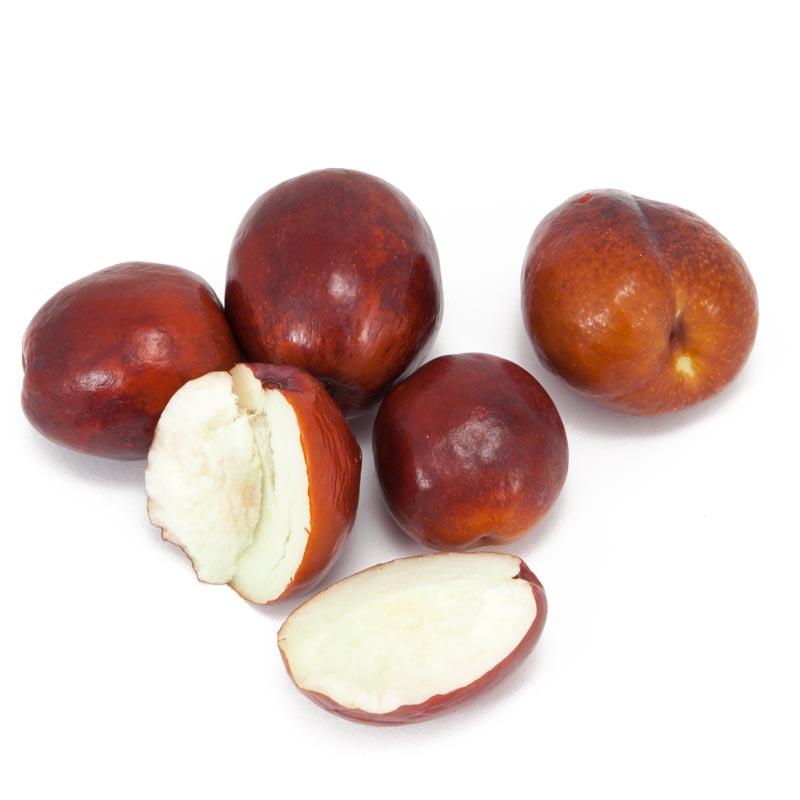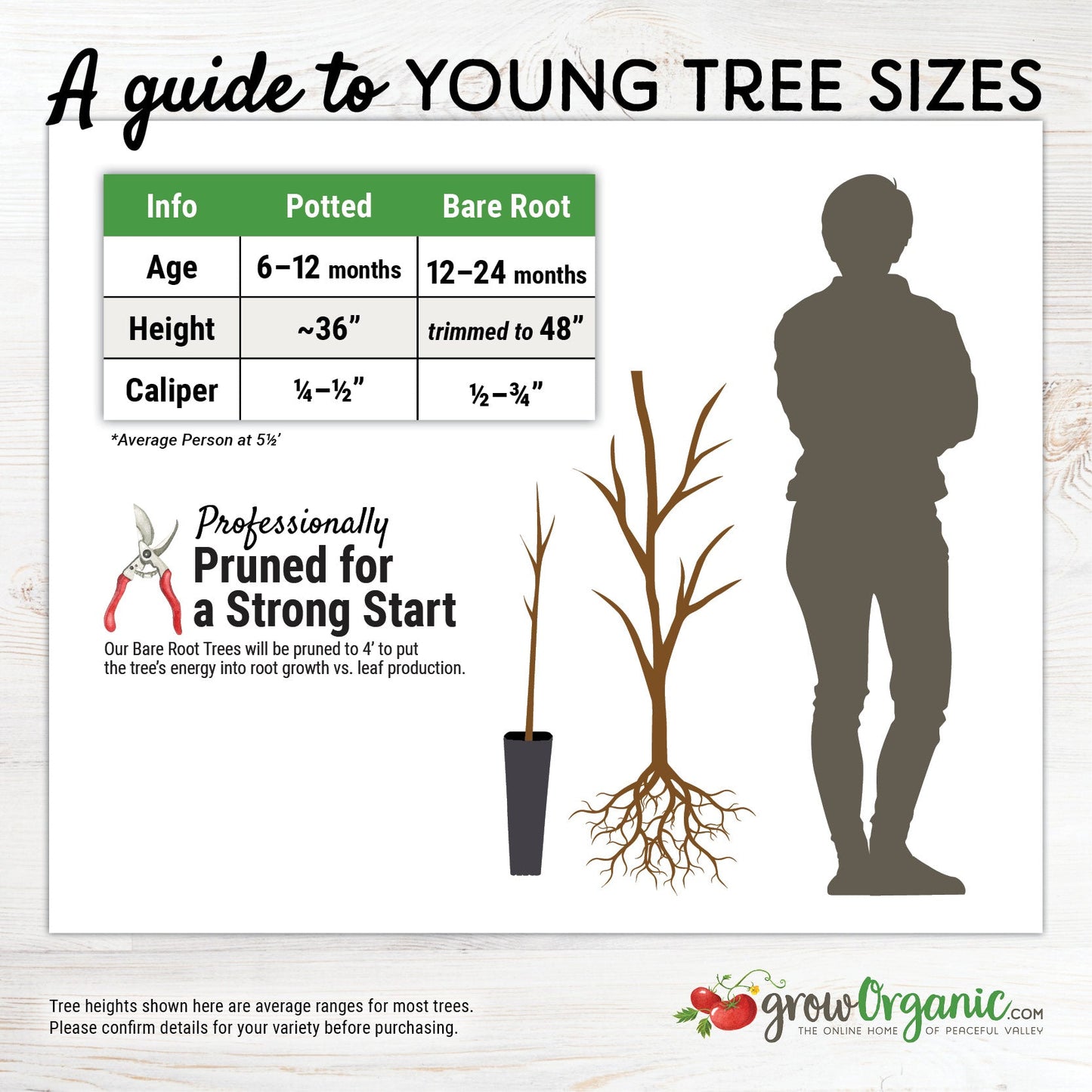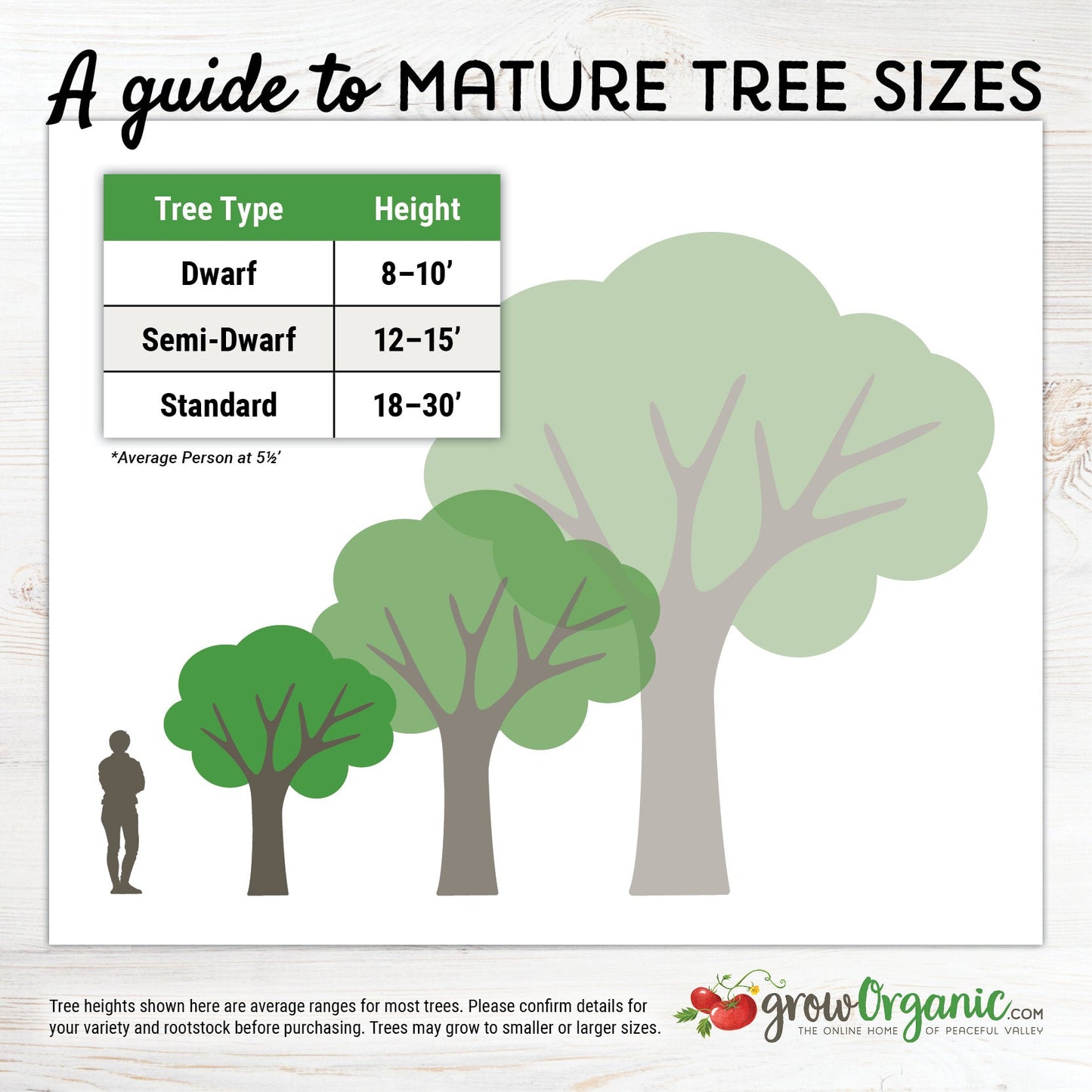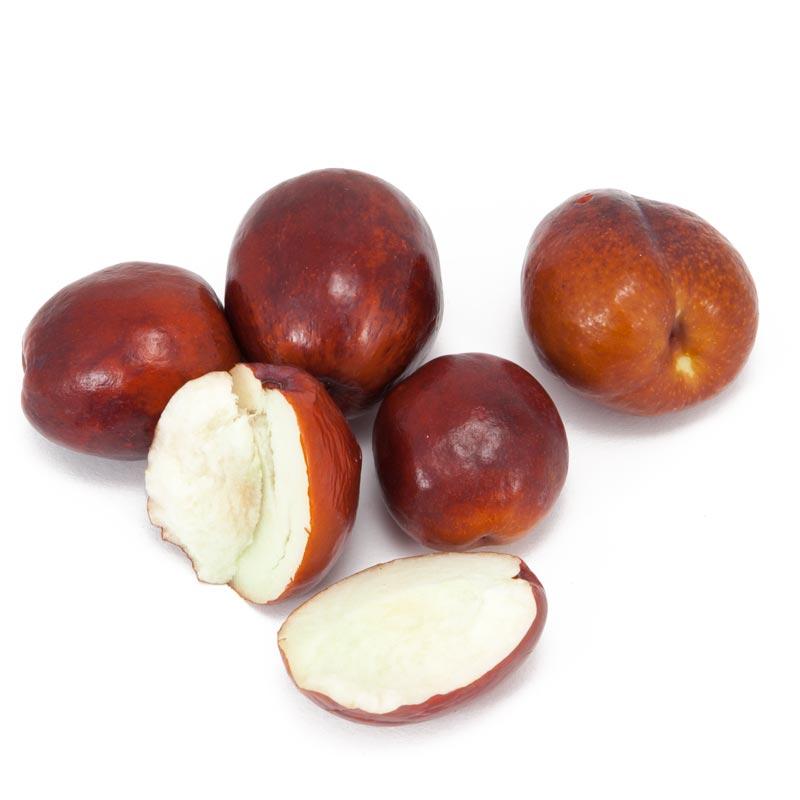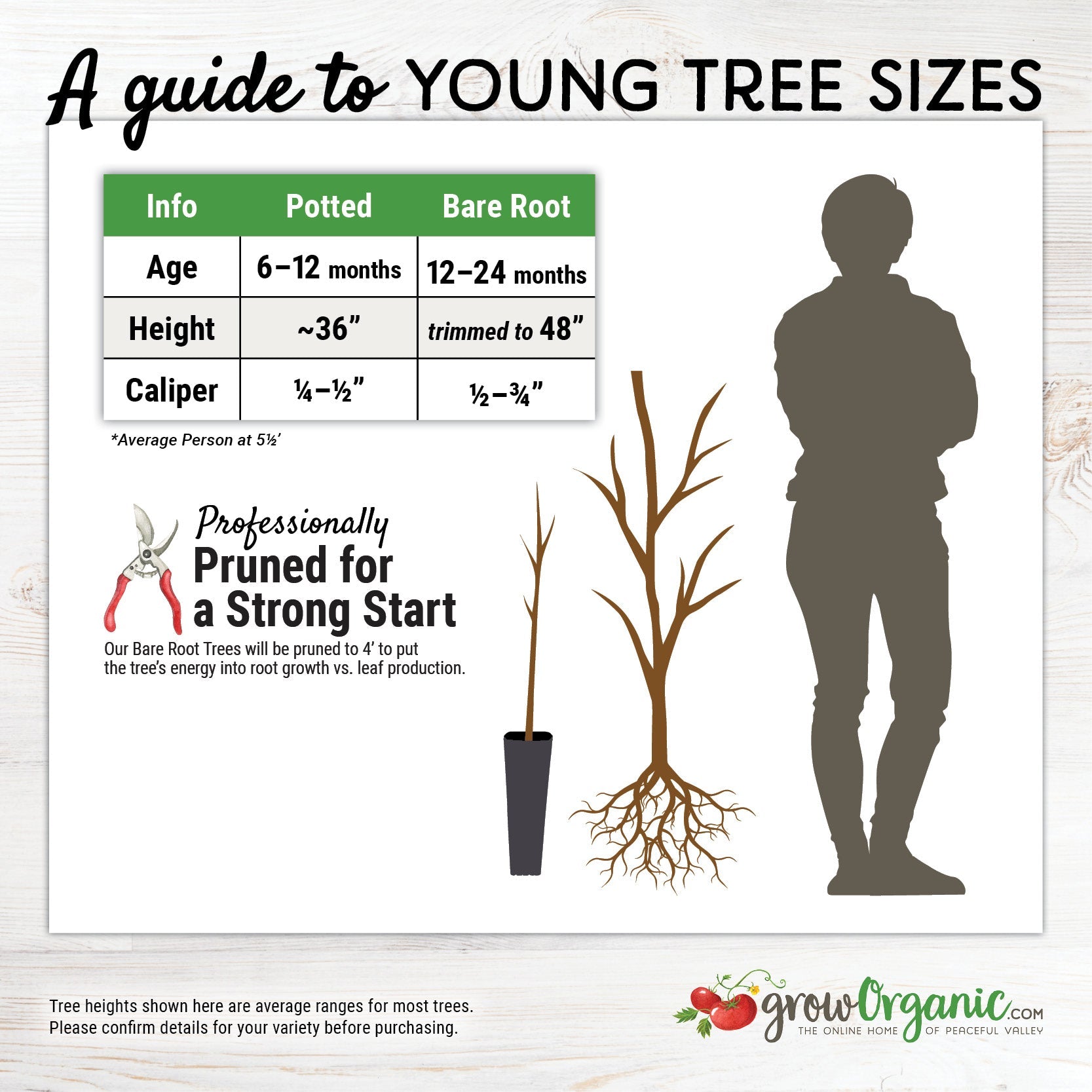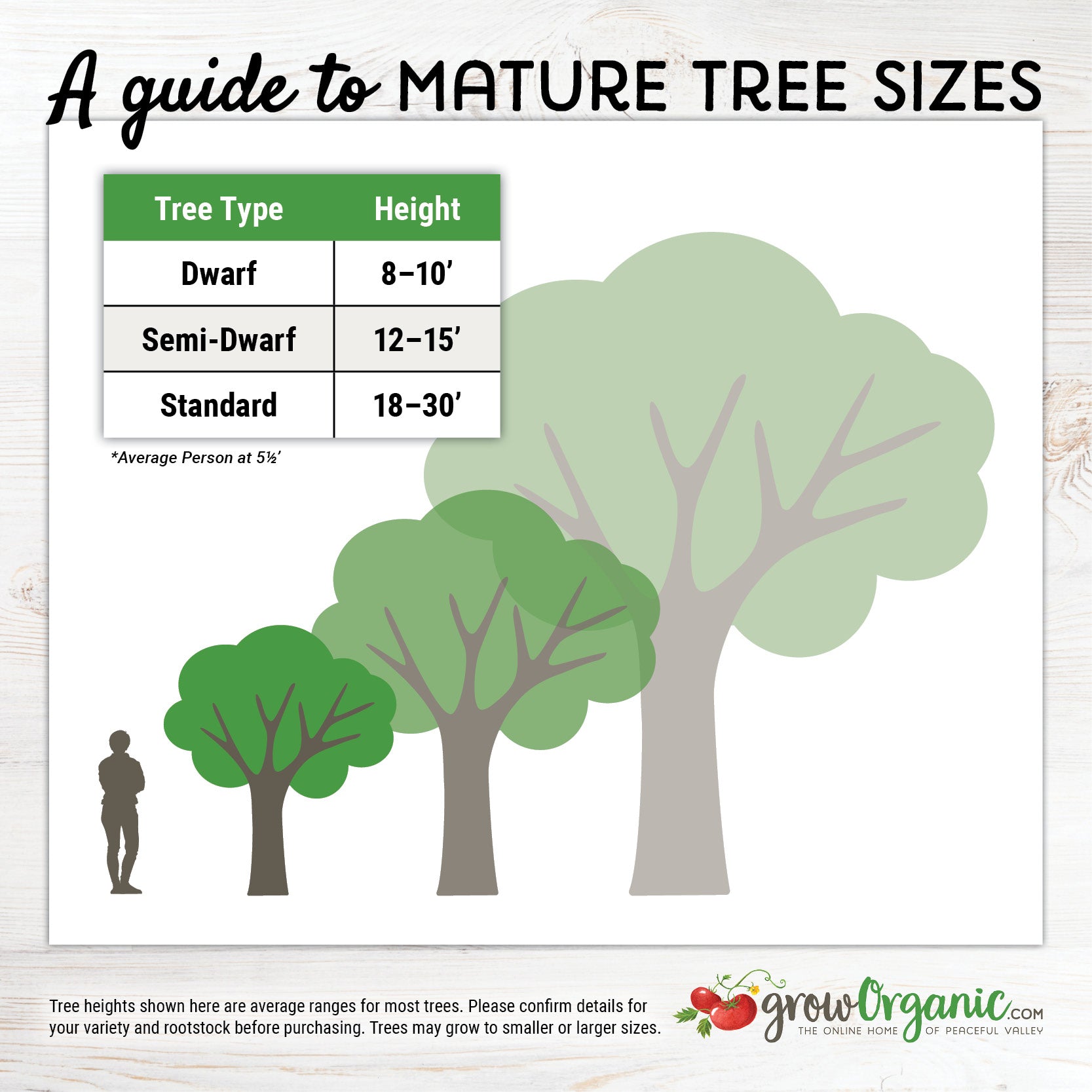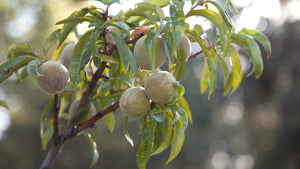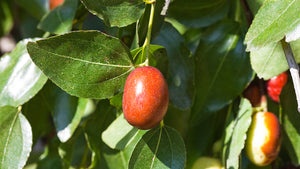Item Number: FT246
Li Jujube Tree
Li Jujube Tree
Attractive, Drought Resistant Jujube Trees
Standard.
- Zones: 5-10
- Chill hours: 150
- Harvest: September 4 - October 15
- Looks: Fruits are reddish-brown, dry, and wrinkled when fully ripe. Li are round-shaped fruit.
- Personality: Sweet and chewy (like dates), also called Chinese Dates.
- Facts of note: Attractive, easy-to-grow tree: hardy, drought-resistant, virtually pest and disease free. Requires long, hot summer.
- Pollination: Self-fruitful
The Li Jujube tree, scientifically known as Ziziphus jujuba 'Li,' is a remarkable fruit-bearing tree that offers a delightful taste of both tradition and modern horticulture. Revered for its sweet and nutritious fruit, the Li Jujube tree has become a favored addition to gardens worldwide.
Understanding the Li Jujube Tree:
Origin: Jujube trees have a rich history, with their cultivation dating back thousands of years, primarily in China. The Li variety is a testament to this ancient tradition, offering a sweet and succulent fruit that connects us to the past.
Size and Growth Habit: Li Jujube trees are typically small to medium-sized, making them suitable for a wide range of garden sizes. They exhibit a graceful, rounded growth habit, adorned with glossy green leaves that provide an elegant canopy.
Fruit: The Li Jujube tree is renowned for its fruit, which is small, round or oblong, and varies in color from green to reddish-brown when fully ripe. The fruit boasts a sweet, crisp, and apple-like texture, making it a delightful treat for fresh consumption.
Adaptability: Li Jujube trees are known for their adaptability to diverse climates and soil types. They thrive in full sun and well-draining soil but can also tolerate drought and less-than-ideal conditions.
Cultivating Li Jujube Trees:
Location: When planting a Li Jujube tree, select a sunny spot in your garden that receives at least 6 hours of direct sunlight each day. Ensuring well-drained soil is crucial to prevent waterlogging.
Planting: Spring is the ideal time for planting Li Jujube trees. Space multiple trees at least 15-20 feet apart to allow for proper growth and air circulation. Dig a hole slightly larger than the root ball, and water thoroughly after planting.
Pruning: Pruning your Li Jujube tree is essential for shaping it, promoting healthy growth, and enhancing fruit production. Perform pruning in late winter or early spring while the tree is dormant.
Watering: While Li Jujube trees are drought-tolerant once established, they require consistent watering during their initial years to establish strong root systems. Opt for deep watering at longer intervals rather than frequent shallow watering.
Fertilization: Apply a balanced, slow-release fertilizer in the spring to provide essential nutrients for growth and fruit development. Be cautious not to over-fertilize with excessive nitrogen, which may favor vegetative growth over fruit production.
Harvesting and Culinary Uses:
Harvesting: Li Jujubes typically ripen in late summer to early fall. Ripe fruit exhibits a reddish-brown color, a sweet aroma, and a crispy texture reminiscent of apples. Harvest them when they reach this stage.
Fresh Consumption: Fresh Li Jujubes are a delightful treat and can be enjoyed straight from the tree. Their sweet, apple-like flavor makes them an excellent addition to fruit salads, desserts, or as a healthy snack.
Drying: Jujubes are often dried, similar to dates, to intensify their sweetness and prolong shelf life. Dried Li Jujubes can be used in a variety of culinary applications, including trail mixes, baked goods, and confections.
Jujube Tea: In some cultures, jujubes are used to make a soothing and aromatic tea. Dried jujubes can be steeped in hot water to create a calming beverage with a unique flavor profile.
The Li Jujube tree offers a sweet and succulent bounty that connects the rich traditions of ancient fruit cultivation with the pleasures of modern gardening. Its adaptability, graceful appearance, and delicious fruit make it a valued addition to gardens of all sizes. Whether you enjoy Li Jujubes fresh, dried, or as a tea, this tree promises a delightful culinary journey while preserving the flavors of history and tradition.
Visit our Fruit Tree Central for a listing of all our fruit tree videos and articles.
Visit Tree Characteristics for a listing of all our fruit & nut tree growing characteristics.


Check Your Zone Compatibility:
Compatible with your zone.
Growing Zone for
,

Our Guarantee To You
Since 1976, we've served our customers at every stage of growing. Please contact us at any time. We are happy to support and assist you.
Description
Description
Standard.
- Zones: 5-10
- Chill hours: 150
- Harvest: September 4 - October 15
- Looks: Fruits are reddish-brown, dry, and wrinkled when fully ripe. Li are round-shaped fruit.
- Personality: Sweet and chewy (like dates), also called Chinese Dates.
- Facts of note: Attractive, easy-to-grow tree: hardy, drought-resistant, virtually pest and disease free. Requires long, hot summer.
- Pollination: Self-fruitful
The Li Jujube tree, scientifically known as Ziziphus jujuba 'Li,' is a remarkable fruit-bearing tree that offers a delightful taste of both tradition and modern horticulture. Revered for its sweet and nutritious fruit, the Li Jujube tree has become a favored addition to gardens worldwide.
Understanding the Li Jujube Tree:
Origin: Jujube trees have a rich history, with their cultivation dating back thousands of years, primarily in China. The Li variety is a testament to this ancient tradition, offering a sweet and succulent fruit that connects us to the past.
Size and Growth Habit: Li Jujube trees are typically small to medium-sized, making them suitable for a wide range of garden sizes. They exhibit a graceful, rounded growth habit, adorned with glossy green leaves that provide an elegant canopy.
Fruit: The Li Jujube tree is renowned for its fruit, which is small, round or oblong, and varies in color from green to reddish-brown when fully ripe. The fruit boasts a sweet, crisp, and apple-like texture, making it a delightful treat for fresh consumption.
Adaptability: Li Jujube trees are known for their adaptability to diverse climates and soil types. They thrive in full sun and well-draining soil but can also tolerate drought and less-than-ideal conditions.
Cultivating Li Jujube Trees:
Location: When planting a Li Jujube tree, select a sunny spot in your garden that receives at least 6 hours of direct sunlight each day. Ensuring well-drained soil is crucial to prevent waterlogging.
Planting: Spring is the ideal time for planting Li Jujube trees. Space multiple trees at least 15-20 feet apart to allow for proper growth and air circulation. Dig a hole slightly larger than the root ball, and water thoroughly after planting.
Pruning: Pruning your Li Jujube tree is essential for shaping it, promoting healthy growth, and enhancing fruit production. Perform pruning in late winter or early spring while the tree is dormant.
Watering: While Li Jujube trees are drought-tolerant once established, they require consistent watering during their initial years to establish strong root systems. Opt for deep watering at longer intervals rather than frequent shallow watering.
Fertilization: Apply a balanced, slow-release fertilizer in the spring to provide essential nutrients for growth and fruit development. Be cautious not to over-fertilize with excessive nitrogen, which may favor vegetative growth over fruit production.
Harvesting and Culinary Uses:
Harvesting: Li Jujubes typically ripen in late summer to early fall. Ripe fruit exhibits a reddish-brown color, a sweet aroma, and a crispy texture reminiscent of apples. Harvest them when they reach this stage.
Fresh Consumption: Fresh Li Jujubes are a delightful treat and can be enjoyed straight from the tree. Their sweet, apple-like flavor makes them an excellent addition to fruit salads, desserts, or as a healthy snack.
Drying: Jujubes are often dried, similar to dates, to intensify their sweetness and prolong shelf life. Dried Li Jujubes can be used in a variety of culinary applications, including trail mixes, baked goods, and confections.
Jujube Tea: In some cultures, jujubes are used to make a soothing and aromatic tea. Dried jujubes can be steeped in hot water to create a calming beverage with a unique flavor profile.
The Li Jujube tree offers a sweet and succulent bounty that connects the rich traditions of ancient fruit cultivation with the pleasures of modern gardening. Its adaptability, graceful appearance, and delicious fruit make it a valued addition to gardens of all sizes. Whether you enjoy Li Jujubes fresh, dried, or as a tea, this tree promises a delightful culinary journey while preserving the flavors of history and tradition.
Visit our Fruit Tree Central for a listing of all our fruit tree videos and articles.
Visit Tree Characteristics for a listing of all our fruit & nut tree growing characteristics.
The Jujube originated in China and its fruits are often referred to as Chinese Dates. It withstands wide ranging temperatures; from over 100° F in summertime to -28° F during winter dormancy. Require minimal chill and plentiful summer sun and heat to set fruit. A small, deciduous tree, growing 20-40 feet, it is well protected from late spring frosts by delayed budding. Prefer sandy, well-drained soils and while tolerating many soil types, do less well in heavy, poorly drained soil. Drought tolerant, but better crop with regular water. Winter prune to maintain plant health. Few pest problems. Immature fruit is green and ripens to yellow-green with mahogany-colored spots and becomes red, softening and wrinkling when fully ripe. Most prefer eating before fully ripe. High in Vitamin C. Please note that Jujube trees have thorns. Suggested plant spacing is 10 feet apart. Browse all our jujube trees for sale.
Please Note: Although most of our bare-root trees arrive to our warehouse in mid-December, there are a few varieties that will not arrive until mid-January. If you order any of those varieties along with varieties that arrive in mid-December, your order will be delayed for shipment until mid-January. If you'd like us to split your shipments, please contact us at (888) 784-1722 or orderdesk@groworganic.com. Additional shipping charges will apply.
Shipping Information
Shipping Information
Cannot ship to the following states: HI, AK, PR, GU, VI
Cannot ship via USPS.
Cannot ship via SmartPost.
Shipping Weight: 5.0 lb
Dimensions: 55.5"L x 7.3"W x 2.75"H
Features
Features
- Self-fruitful
- Suited to Warmer Climates
Characteristics
Characteristics
Planting & Care
Planting & Care
Useful Information
Useful Information
Guarantee
Guarantee
Limited Dormant Tree & Plant Guarantee
* Claim deadline is June 15th
We guarantee that your dormant tree or plant will arrive in good, viable condition. If your tree arrives in substandard condition, notify us within 3 days of delivery. Please email pictures of the box, inside packaging, the tree and its roots to helpdesk@groworganic.com. We will investigate your claim and process a request to exchange or refund the damaged product.
If your dormant tree or plant has not grown new leaves by June 15th, you may be eligible for our Limited Dormant Tree & Plant Guarantee. This guarantee provides for a store credit for the purchase price of the tree, excluding shipping. Please see the Instructions below.
Important Dates:
- April 1st Dormant trees/plants must be planted in the ground
- May 15th Perform scratch test, if no new leaves have grown
- June 15th Deadline to apply for a dormant tree/plant credit
All required documentation must be received by June 15th for your claim to be considered. Claims or documentation received after June 15th will be denied, without exception. Instructions listed below
Terms and Conditions
We cannot guarantee that your tree or plant will remain alive and healthy after it is received, or bear fruit as there are too many variables in your environment that are beyond our control (i.e. soil preparation, weed and pest control, proper irrigation, chill hours, compatible hardiness for your growing zone, proper choice of pollinator, extreme weather, rodent damage, disease, etc.).
We cannot guarantee that we will be able to provide a replacement tree/plant of the same species either that same growing season or in future years. Customers are responsible for all shipping fees associated with replacement trees and plants.
If we determine that the tree you purchased directly from us is not viable, we will issue you a store credit (not a refund) for the purchase price of the affected dormant tree or plant. Shipping is not included in the dormant tree/plant guarantee. Store credits can be used to purchase any product we sell and are valid for use only until July 1st of the following year.
Historically, 98% of our dormant trees and plants grow and thrive when they have been cared for and planted using our growing guides. Dormant trees and plants must be planted in the ground by April 1st in order to be eligible for credit. If the ground in your area is still frozen solid, you may temporarily plant your tree or plant in a pot.
Potted, non-dormant trees or plants are excluded from this guarantee as they are not dormant at the time of shipment. Evergreen trees such as citrus, avocado and olive trees are not available for credit under the Dormant Tree and Plant Guarantee.
Instructions
We guarantee that your dormant fruit tree or plant will leaf out, if you care for it according to our growing guides. In the unlikely event that your dormant tree or plant does not have leaves by May 15th, follow these simple steps to apply for a store credit:
Before you call or email, please perform a “scratch test” to determine if the tree or plant is still alive. This video shows how to check for live tissue under the bark. Scratch tests need to be done a few inches above and below the graft.
Green Cambium Layer / Living Trees
If the cambium layer under the bark is green, give your tree a little more time. It is still alive, but hasn’t come out of dormancy yet. Check to make sure that it is getting the right amount of deep root water, enough sunlight and that the weather is warm enough for that type of tree/plant to come out of dormancy. Every tree has its own personality and will come out of dormancy at different times. Be sure to submit the required documentation listed below by June 15th, if it doesn’t grow leaves.
Brown Cambium Layer / Dead Trees
If the scratch test shows a brown cambium layer or if your dormant tree/plant doesn’t have leaves by June 1st, please email us at helpdesk@groworganic.com. All required documentation listed below must be received by June 15th for your claim to be considered. To be considered for the guarantee claim, all required documentation must be received by June 15th. Incomplete submissions will be denied.
Required Documentation
- Order number
- Name of dormant tree/plant and the quantity affected
- Photos of each tree or plant showing:
- The roots (tree or plant must be pulled out of the ground)
- The scratch test areas
- The entire tree/plant
We reserve the right to not issue credit for items that have already been replaced. We also reserve the right to require photographic evidence that the tree/plant was not killed by root rot, rodent or mechanical damage.
Share
